All systems are go for the inaugural ground test firing on March 11 of the world’s most powerful solid rocket booster ever built that will one day power NASA’s mammoth new Space Launch System (SLS) heavy lift rocket and propel astronauts to deep space destinations.
The booster known as qualification motor, QM-1, is the largest solid rocket motor ever built and will be ignited on March 11 for a full duration static fire test by prime contractor Orbital ATK at the newly merged firms test facility in Promontory, Utah.
Ignition of the horizontally mounted motor is planned for 11:30 a.m. EDT (9:30 a.m. MDT) on Wednesday, March 11 on the T-97 test stand.
The test will be broadcast live on NASA TV.
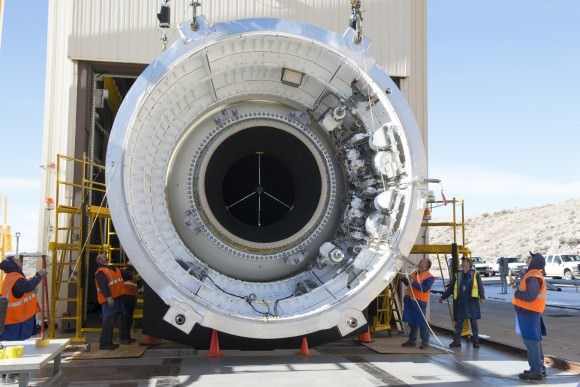
The two minute long, full duration static test firing of the motor marks a major milestone in the ongoing development of NASA’s SLS booster, which is the most powerful rocket ever built in human history.
The 5-segment booster produces 3.6 million lbs of maximum thrust which equates to more than 14 Boeing 747-400s at full takeoff power!
The new 5-segment booster is directly derived from the 4-segment booster used during NASA’s three decade long Space Shuttle program. One segment has been added and therefore the new, longer and more powerful booster must be requalified to launch the SLS and humans.
A second test is planned a year from now and will qualify the boosters for use with the SLS.
Teams of engineers, operators, inspectors and program managers across Orbital ATK’s Flight Systems Group have spent months getting ready for the QM-1 test. To prepare they started countdown tests on Feb 25.
“The crew officially starts daily countdown test runs of the systems this week, at T-15 days,” said Kevin Rees, director, Test & Research Operations at Orbital ATK.
“These checks, along with other test stand calibrations, will verify all systems are ready for the static test. Our team is prepared and we are proud to play such a significant role on this program.”
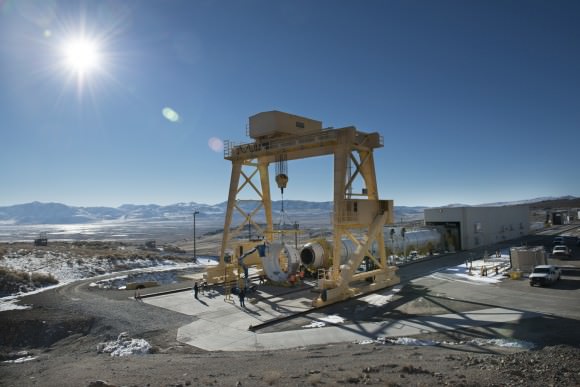
The QM-1 booster is being conditioned to 90 degrees and the static fire test will qualify the booster design for high temperature launch conditions. It sits horizontally in the test stand and measures 154 feet in length and 12 feet in diameter and weighs 801 tons.
The static fire test will collect data on 103 design objectives as measured through more than 534 instrumentation channels on the booster it is firing.
The second booster test in March 2016 will be conducted at lower temperature to qualify the lower end of the launch conditions at 40 degrees F.
The first stage of the SLS will be powered by a pair of the five-segment boosters and four RS-25 engines that will generate a combined 8.4 million pounds of liftoff thrust.
The SLS is designed to propel the Orion crew capsule to deep space destinations, including the Moon, asteroids and the Red Planet.
The maiden test flight of the SLS is targeted for no later than November 2018 and will be configured in its initial 70-metric-ton (77-ton) version with a liftoff thrust of 8.4 million pounds. It will boost an unmanned Orion on an approximately three week long test flight beyond the Moon and back.
NASA plans to gradually upgrade the SLS to achieve an unprecedented lift capability of 130 metric tons (143 tons), enabling the more distant missions even farther into our solar system.
The first SLS test flight with the uncrewed Orion is called Exploration Mission-1 (EM-1) and will launch from Launch Complex 39-B at the Kennedy Space Center.
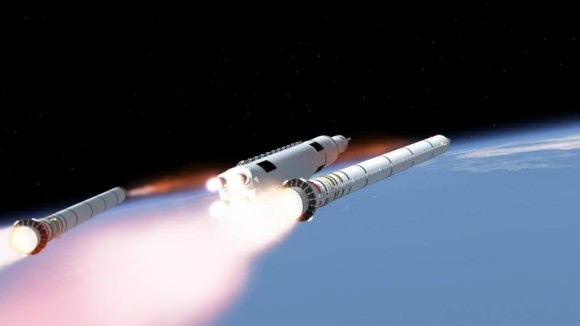
Orion’s inaugural mission dubbed Exploration Flight Test-1 (EFT) was successfully launched on a flawless flight on Dec. 5, 2014 atop a United Launch Alliance Delta IV Heavy rocket Space Launch Complex 37 (SLC-37) at Cape Canaveral Air Force Station in Florida.
Orion’s inaugural mission dubbed Exploration Flight Test-1 (EFT) was successfully launched on a flawless flight on Dec. 5, 2014 atop a United Launch Alliance Delta IV Heavy rocket Space Launch Complex 37 (SLC-37) at Cape Canaveral Air Force Station in Florida.

Stay tuned here for Ken’s continuing Earth and Planetary science and human spaceflight news.
. ………….
Learn more about MMS, Mars rovers, Orion, SpaceX, Antares, NASA missions and more at Ken’s upcoming outreach events:
Mar 9-11: “MMS, Orion, SpaceX, Antares, Curiosity Explores Mars,” Kennedy Space Center Quality Inn, Titusville, FL, evenings
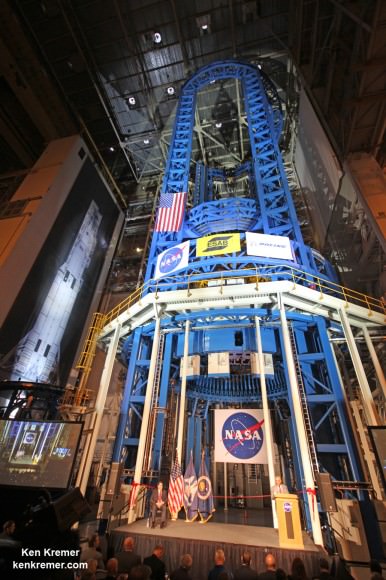

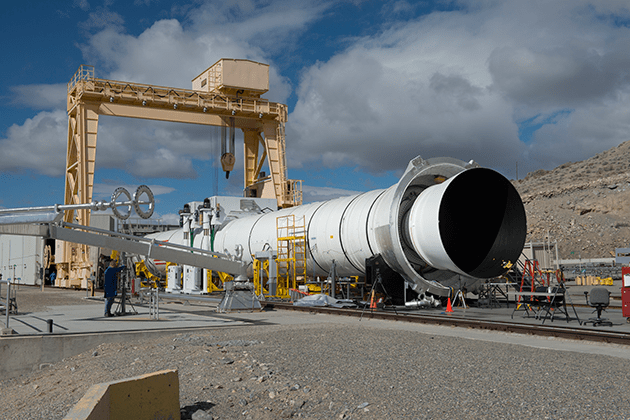
Could you please use metric units in future articles. Pounds, feet, degrees F etc mean nothing to us guys outside America. 96% of this planet live in a metric environment and we scientific types have been metric for donkey’s years! Remember the Mars mission which failed because of a units muddle? So, please, come into the 21st century and go metric!
The US went to the Moon. The US went to Mars and the planets and beyond. The 96% did not. What does that tell you about the differences between YOUR way and ours?
It says that you stupidly honor the old imperialists who colonized you. Even to the price of crashing your own Mars missions.
How many of that 96% even made it into space, let alone to the moon? I do, however, agree with Keith Atkin. We really should join the rest of the world and go metric. It would be easier in the long run.
JetMech, we can’t rest on past deeds from decades ago. We must constantly adapt to stay competitive and move ahead. There is nothing to fear. We can adapt and excel.
It tells me that the Americans were lucky to get their hands on some Germans to develop a) the rocket (Wernher von Braun and his friends), b) the nuclear bomb (German submarine U-234, Oppenheimer, Hahn… typically american names, eh?), modify a camera to make it fit for space (Hasselblad = Sweden… not US) and a lot of other non-US- stuff.
The problem with a lot (not all !!) of Americans is…. they learn & believe that only America is capable of doing this. There is a reason why America has such a bad reputation… worldwide. So let’s wait ’till the tsunami from La Palma is over… and talk to the survives 😉
I’m American and I agree with this. For scientific and technical uses, even in the U.S., metric is the only reasonable choice. And has been for the last 40 years.
Aluminum Perchlorate… Boooo! Yuuuk!
For a timely look at the fuel the SLS SRBs should be running on, please refer to this 12yr old NASA article (an oldie but a goodie):
http://science.nasa.gov/science-news/science-at-nasa/2003/28jan_envirorocket/
Much as monster rockets are awe inspiring , am not too sure about the SLS. Read somewhere that SpaceX can achieve similar goals with smaller rockets and distributed payloads. Important points being high efficiency and low cost. So whats the deal in the long run?
This is the wrong direction. By definition a solid booster will not be able to reignite, land, and be used for another launch. NASA is making the largest throwaway piece in history. Anybody in any position of authority want to step in and stop our government from jumping off this cliff?
But it keeps ATK employed in somebody’s state/district.
In the end, that’s it. The US Congress (not NASA engineers, the agency didn’t ask for this rocket at all) drew up the specifics for the Space Launch System such that only the old Shuttle contractors could provide the hardware. It was never meant to be a ‘clean sheet’ design. Boeing and SpaceX had much cheaper proposals for the same payload to orbit.
http://www.thespaceshow.com/detail.asp?q=2174
Thanks delphinus100. I’ll give the show a listen to and if it is a normal podcast subscribe to it.
Even if the SLS is a jobs program our US Congress should plan ahead. Any idiot can see the outcome and our Congressmen are not THAT stupid they can’t see the outcome. Sending us down a path that will lead us stranded in the boondocks is destroying our country.
> By definition a solid booster will not be able to reignite, land, and be used for another launch.
The shuttles solid rocket boosters landed and were reused.
The shuttle SRBs did so by landing in water with chutes. The cost of inspection/reconditioning after salt water damage was apparently close to that of purchasing new stacks. The above posts (mine included) refer to solids/hybrids which can start/stop/re-light and therefore possibly flyback similar to spaceX boosters.. The idea being true reusability in which the largest cost is inspection and refuelling..
I don”t knowo what all the excitement is all about. Anything that we are doing in space is largely irrelevant.
Chemical rockets: their high cost of development and relatively low payload capacity all means one thing.
Chemical rockets are a dead end. For space exploration to become “economical” there needs to be another way to put a payload into orbit. Even Scaled Composite’s Strato-launcher while does lower the cost of a launch it really doesn’t achieve much more than a “discount”.
For industry to move into space then massive tonnage needs to be launched. And that will NEVER happen.
Even if Giga-structures such as the Space Elevator were proposed, the entire Gross World Product could not support it’s design, development or construction.
So space exploration using chemical rockets is just a curiosity and while it does move material science forward it will never be anything more than an expensive tax sink-hole for rich nations and an expensive hobby for rich men like Paul Allen and Elon Musk.
Humans cannot survive in zero gravity and people can survive marginally in low gravity. Therefore ANY serious exploration means a ship capable of spinning to generate the effects of gravity and that would be insanely expensive.
But having said all of that, I’d much rather see tax dollars spent on building and developing space technology rather than designing and building more efficient bombs to drop on folks that we do not agree with politically.
So lets not get too excited over a bigger roman candle. Because essentially we have not really done anything more than improve upon that first Chinese rocket launched in 1232.
In fact you could probably ignite QM-1 with a match.
Newton’s third law will not go away.
You are going to orbit with a high thrust engine of *some* kind, or not at all. (even doing airbreathng for some part of the ascent doesn’t seriously change this) The alternative is high-thrust nuclear thermal, which has serious PR problems.
‘Chemical rockets’ are a known, mature, high thrust-to-weight technology. And on Earth, their fuel possibilities are plentiful and cheap. (those who complain about ‘deep gravity wells’ miss that last fact. Fuel cost is not the issue.)
Newton doesn’t have to go away. New technology that is NOT CHEMICAL based needs to be discovered.
And as I said, chemical rockets were invented in 1232 and all that has happened since then is they got bigger.
Fuel is NOT cheap. It is getting more expensive everyday.
You are right. Fuel prices are currently around $300,000 for a rocket SpaceX or ULA would send up for a large satellite. However relative to the $300,000,000 ULA charges for the rocket the price of fuel is only about .1% of the total price.
Kind of like your car. $60 to fill it up. $60,000 to buy it. $60 is not cheap but compared to the price of your car it is.
Actually your argument is specious. QM-1 is fabricated from OLD STS solid rocket booster casings and is NOT reusable.
I don’t know where you got you refueliing cost but each booster burns 1.6MILLION pounds of fuel.
$300THOUSAND does not even begin to cover that fuel.
So you are saying the propellant cost to refuel is $0.19 per pound?
Your analogy of a $60THOUSAND car is also specious. The car is only good for ONE FILL UP.
QM-1 is not a reusable rocket. It is built up from old spent STS casings.
The fuel “cost” goes beyond the unit price of fuel.
Liquid fuel rockets ARE NOT REUSABLE.
QM-1 is also not reusable. Or at least NASA isn’t planning on recovering them.
> New technology that is NOT CHEMICAL based needs to be discovered.
You mean, let’s sit around and wait 100 years before some scientist finds a way to have pocket fusion.
Chemical is the only way to let a human and most sensitive payloads survive a launch trip.
Launching a rocket into orbit has 2 problems:
1. You need to get a minimum speed of 28,000 km/h or you just fall back.
2. You need massive energy just to get beyond the tower. If it cannot overcome the gravity then the rocket just sits there burning all the fuel and move not even an inch.
Not sure why I can’t reply to your latest comment. Maybe the site’s software only allows a certain depth of replies.
Anyways when you say things like:
“Liquid fuel rockets ARE NOT REUSABLE.”
and
“$300THOUSAND does not even begin to cover that fuel.”
I think you misread what I wrote. I’m not talking about the QM-1. (Which I have nothing but very very very negative things to say about.) If you are talking about the QM-1 then I agree. It is not meant to be reusable. It is basically a welfare program that damages our country in many ways. Everybody associated with this boondoggle, including Congress, should be put in prison. Or put in a concentration camp like we did with the V-2 engineers and told to build reusable rockets. (Yes, my blood boils and I lose control when I see any mention of the SLS program.)
As for reusable liquid rockets costing two to three hundred thousand dollars to refuel please follow this thread:
http://forum.nasaspaceflight.com/index.php?topic=36962.0
There’s a dozen 10+ tons to LEO launchers in action today. Everyone loves to pay the billions to develop new ones, the cost of developing yet another launcher is obviously not at all the problem in any way. And the fuel costs of a launch is only about 2% of the cost of the rocket, so reusability immediately makes chemical rockets look brilliant and most economic,.
Space elevators are not only impossible to build, they are most unattractive as launching facilities. It is a logistical nightmare. One tiny payload at a time would slowly climb that 100 000 km tall wire. As with any one-dimensional structure, any problem anywhere immediately stops all operations. A space elevator would be so totally inflexible and vulnerable and dangerous that it wouldn’t be used even if it could exist.Chemical rockets are way superior in every way: Much much cheaper, reliable, flexible and possible.
“…they are most unattractive as launching facilities.”
Say what???? Seriously????
Who cares what it looks like.
“Chemical rockets are way superior in every way”
Chemical Rockets are only superior in ONE way. They are all we have got.
“A space elevator would be so totally inflexible and vulnerable and dangerous ”
Just how flexible does it have to be? Stuff goes up and stuff comes down? The space elevator is a really big weight in geosync orbit tethered to the earth. The only limit is the mass of the weight in orbit. As the tethered mass increases so does the amount of mass that can be lifted into orbit. Of course the tether is pretty dam long and would have to be manufactured from materials that are only being thought of today. Of course nobody thought that Burt Rutan could “weave” a FRP spaceship together either. Certainly not Robert Goddard or Werner von Braun.
The tether is basically a shaft that a very large “car” can climb or crawl upwards at an acceleration rate of several kilometers per hour.
Is it risky to build? Sure it is. So wasn’t the Golden Gate Bridge. But it would be the only way to put millions of tons and thousands of people into orbit cheaply. Especially if ships are to be built in orbit. And the asteroid belt is gong to be mined.
Like the Challenger wasn’t vulnerable or dangerous?
The Space elevator can’t be built NOW. But in maybe 50 years? Who knows. It’s either that or we beam stuff up and that is even less likely!
Someone once said that going 60mph was impossible, of course that was when trains only went 40mph.
The amounts of mass which would have to be launched from Earth to build a space elevator is so enormous that it constitutes a prohibitive threshold. It’d be better to launch the useful payload directly instead. The space shuttle and ISS experience clearly points in that direction. What if 50+ space shuttles had launched interplanetary probes and space telescopes instead? The trade off is whether we should we spend 50 years launching interplanetary probes two times a year, or skip that to instead build a very long elevator tether for small payloads?
Space elevators are technologically feasible on low gravity objects like Phobos. But then again, you could achieve escape velocity from Phobos by using a bicycle. Once traffic becomes dense enough, stuff like subways become rational. We’re not there yet, and see no path towards that horizon. Space elevators are sci fi, not a real concern for the space flight community.
“The amounts of mass which would have to be launched from Earth to build a space elevator is so enormous that it constitutes a prohibitive threshold.”
That is your opinion. Unless of course you can support your opinion with FACTS.
Even if there is a cost thresh hold, the entire economy of Space development has a cost threshold based on the energy cost to place a payload into orbit. For Human occupation of space to become successful a gravity simulating enivronment is necessary: rotating a very large wheel.
Using chemical rockets orbital manufacturing on a large scale will never happen. Space exploration will never become a commonplace endeavor. It will always be politically motivated to justify the expense. It will never become self supporting except when giving rides to rich folks.
I’m not saying that we should stop space exploration. I am saying that NASA needs to begin a dialogue for the next step.
And barring “teleportation” the Space elevator IS the only cost effect means to move mass into orbit.
The COST to build Golden Gate Bridge was staggering 70 years ago at $35MILLION during a deprssion. BUT the economic benefits far outweighed the cost in a matter of just a decade or so. However Golden Gate would likely cost in excess of $6 BILLION today and the political will would not be there to even consider it. Just consider how much the new Bay Bridge is going to cost!
A Space Elevator would require a usefull life of likely more than a hundred years. Just like Golden Gate.
Thresholds change over time as the synergy of economic benefit and political will changes.
I am also not saying that a space elevator could even be built as it would require the entire GWP (Gross World Product) today to accomplish it even if the materials were available. Again political will would have to be there and political will only comes from motivated self interest like spending $13 TRILLION on two useless wars in the middle east.
But I do know that chemical rockets are a dead end.
Chemical rockets are perfect and optimal.
They elegantly avoid the problem with the thick atmosphere by slowly accelerating through it. They are run on fuel which is endlessly abundant on Earth and gets ever cheaper by the day. They provide high thrust and full flexibility. You can build one of them, or a thousand (like the Russian R7/Soyuz) according to your needs. You can launch them from the Arctics or from the equator as you please. Chemical rockets are much better in every way. Much better than sitting around waiting for the elevator in the wrong building.
JetMeck your American cars are not metric and the World Knows their Great Reputation ….Your more Isolated than Pre War Japan and because of your inferior Education System you can NOT learn a Superior System 🙂 and Von Braun used the Metric System when he designed and built (your) American Rockets…Smoke That!
The US does not export cars. Have a look at any street in Europe or Japan and you will immediately understand that the US does not export cars. The Old Imperialist American cars with their inch-feet-mile gallon confusion actually doesn’t go very far.
Haha, I see your tenth and raise you one twelfth 😉
I won the Internet today (for the next 12 hours 😉
At first sight it might seem a good idea to reuse established technology based on the Shuttle. Copying the brilliant Soviet Energia system. But since everything has to be remade, the SLS loses all those potential benefits. The boosters are redesigned and must now be retested. The launch pad, the crawler, a barge, a building, the main engines and on and on must all be redesigned at huge costs. Only to get NASA to where it was 50 years ago. It is like running an Apollo program all over again but without the budget or demand for it. SLS is old, but it lacks the benefits of experience which all other old launch systems have. SLS is more expensive, more risky and takes longer to achieve than a modern launcher design from scratch.
— SLS is more expensive, more risky and takes longer to achieve than a modern launcher design from scratch.
Starting from scratch again is no guarantee that this time it will be better. I see that happening all the time in software projects. Sometimes you have to bite the bullet ans solve the issues that you are facing instead if gong the easy way and start all over again.
The Saturn V design and the Shuttles SRB are proven designs. The redesigned reusable Space shuttle was a a mess.
There is also a psychological factor. The fact that SLS looks like a very successful Saturn V on steroids brings back the good old memories that the US meant something in space and kicked Russian *ss. When the Americas are proud of their rocket then it also increases funding over the long run.
Also it is really irrelevant if the SLS costs a lot, as long as it goes back to the American people by creating more jobs. It is good for the economy. Very good for the American economy.
@Olaf
Your stalinist view that “costs are irrelevant” is a very dangerous kind of view, and a view which has murdered millions of people “because they didn’t cost much”. You should look out for such fascist memes in our mind. If you think that work without purpose is good, then please try to think again!
If you try to think about it for a minute. The SLS is not creating jobs. The SLS is absorbing some of the most skillful rocket scientists around. Instead of letting them create better rockets, they are bribed to go 50 years backwards and re-create a Saturn V. Fine for them, but it won’t get humans to space.